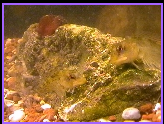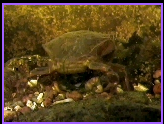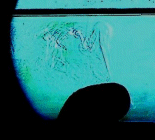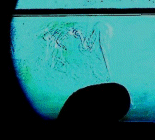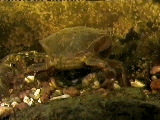features@
seashoreantics.com
features@
seashoreantics.com
Common Mussel (Mytilus edulis)
Common Mussels are filter feeders. To see the work done with the naked eye is difficult. Up close it could be noticed that the bivalves are open and perhaps a flutter of the exhalent syphon could be seen, as the fluid flow exits.
With scientific photography, the work of the mussel can be clearly seen. Here the mussel was filmed using the Schleiren Method of photography, where by the refractive index of the water is seen to be different where the fluid flow is present and the imaging technique allows this to be visualised by focusing and recontrolling the refracted light rays.
This animated sequence of a few frames taken from a continuous video recording of the event demonstrates that scientific photography can show what is otherwise invisible.
mouse over here to animate
Shore Crab (Carcinus maenas)
Shore crabs eat mussels, amongst other things. Scissoring their way into a Common Mussel shell can take an hour or so of continous effort. The nutritional reward would need to exceed this investment of energy in order for the crab to exist, grow and reproduce. As well as the crabs own calculations on this work, there is the interaction with the other creatures of the environment that effect the end result.
In this animated sequence, the crab has already broken open a mussel shell. Although still having hold of it, the crab is being 'mugged' of some of the rewards, by passing Blennys stealing the meat on an oppotunistic feeding spree.
mouse over here to animate
Munching - Feeding/attack & defence
Challenging the usual format found in most websites of being told in writing what the creature feeds on, is what Sea Shore Antics is about.
The reality of the work load that goes into obtaining their daily nutritional requirements is frought with effort and competition to pit their minds and physical ability to use their individual 'tools of the trade' to successfully gain more energy than they expend.
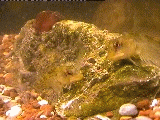

Common Blenny (Lipophrys pholis)
Common Blennys will go for the opportunistic feed on the meat of most things it can get a bite on!
They have serious teeth that are both sharp and strong. Sharp and strong enough to nip off the legs of feeding barnacles.
In this animated sequence, the Blenny can be observed on the rock covered in barnacles, looking at one wafting its extended legs outside its shell to feed for itself. As the Blenny strikes, it succeeds in nipping the legs off, as well as some of the protective plates that usually protect the barnacle when closed. The teeth are sharp enough to nip off the legs and strong enough to take a bit of impact on the outer shell.
mouse over here to animate
Cussion Starfish (Asterina gibbosa)
When hungry, a starfish will find a bivalve shellfish, like a mussel, and crawl onto it. Each arm has many suckers which can provide plenty of grip to pull the shells apart. The opening is just enough to allow the starfish to perform its special trick.......... It pushes its stomach out of its mouth, then posts it through the gap between the shells.
These scientific cut-away images, shown as an animated sequence, show the stomach being posted. Once inside, special juices on the stomach, turn the shellfish within, into a thick soup. All the nutrition in the soup is slowly absorbed through the stomach and up into the starfishs body where it is stored for later use. When hunger is satisfied, the starfish pulls its stomach back inside itself and potters off.
